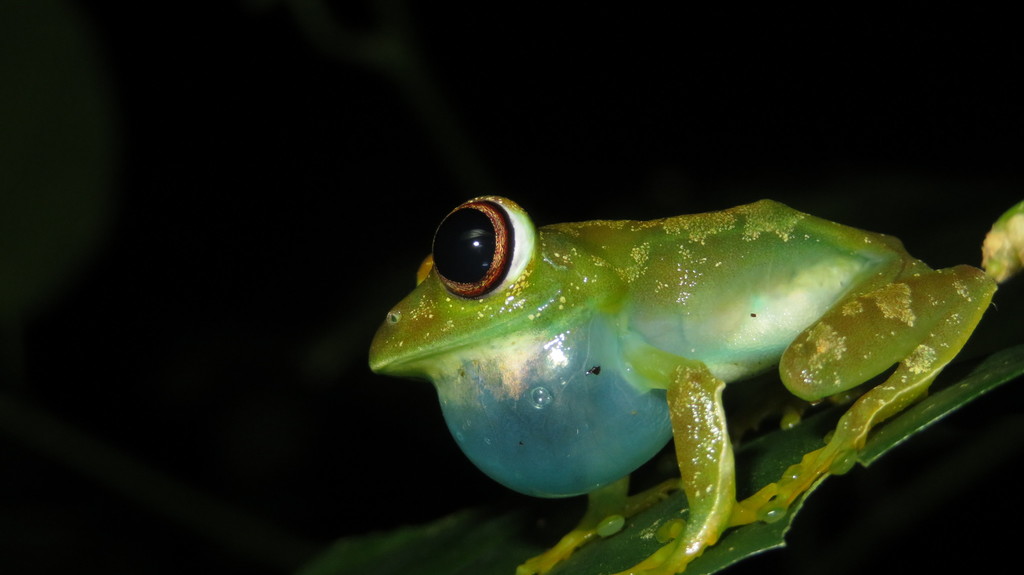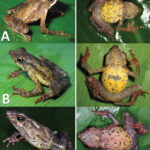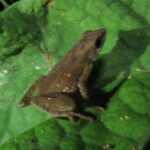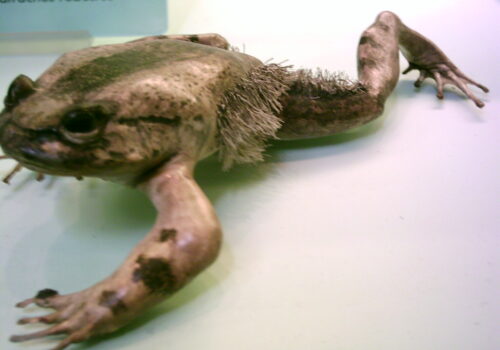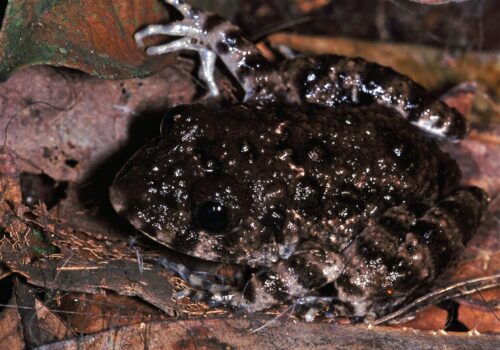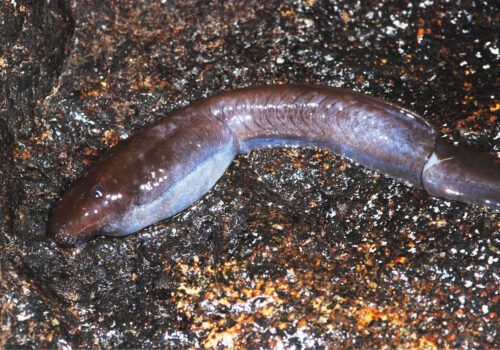- Leptopelis grandiceps: Unveiling the Secret Life of the Big-Headed Forest Tree Frog
- Introduction: Meet East Africa's Enigmatic Amphibian
- Taxonomy and Classification
- Natural Habitat: Finding Sanctuary in Tropical Forests
- Physical Characteristics: Enchanting Adaptations in a Tiny Package
- Behavior and Life Cycle: A Captivating Dance of Survival
- Ecological Role: Guardians of Forest Harmony
- Threats and Conservation Status: Preserving Fragile Existence
- Cultural and Scientific Significance: Fostering Respect and Curiosity
- Conclusion: A Call to Protect the Quiet Guardians of Our Forests
Leptopelis grandiceps: Unveiling the Secret Life of the Big-Headed Forest Tree Frog#
Introduction: Meet East Africa’s Enigmatic Amphibian#
Nestled within dense, lush tropical forests, amidst mist-laden canopies and the rhythmic symphony of nocturnal creatures, dwells an enchanting yet often elusive amphibian: the remarkable Leptopelis grandiceps. Known colloquially as the Big-Headed Forest Tree Frog, this intriguing frog is not only captivatingly unique in its physical appearance and vocal repertoire but also serves as an important indicator species vital to understanding the health and biodiversity of East African forest ecosystems.
The name grandiceps literally translates to “large head,” a nod to its distinctively oversized head and expressive eyes—features that instantly pique the curiosity of researchers and wildlife enthusiasts alike. Let us venture together into the verdant hideaways where this wondrous species reveals its secretive existence and explore the powerful, fragile balance they represent.
Taxonomy and Classification#
Understanding the taxonomic lineage of Leptopelis grandiceps sets the context for exploring this exceptional frog. Belonging to the family Arthroleptidae, the genus Leptopelis comprises a diverse array of forest-dwelling or arboreal frogs primarily distributed across sub-Saharan Africa.
Leptopelis grandiceps was formally described by the Swedish zoologist Einar Lönnberg in 1929. This species shares its family with a diverse array of African frogs, each with unique adaptations for their specialized forest habitats. Among its closer relatives, the juxtaposition of morphology and vocalization patterns helps experts delineate remarkably insightful evolutionary relationships and adaptations within this intriguing amphibian lineage.
Natural Habitat: Finding Sanctuary in Tropical Forests#
Leptopelis grandiceps inhabits the humid forests native to Eastern Africa, particularly regions encompassing Tanzania and Kenya, especially within montane forest ecosystems. Seeking refuge in lush upland rainforests between altitudes of approximately 1,200 to 2,200 meters, these frogs have adapted spectacularly well to dense foliage environments that offer abundant moisture, shaded shelter, and diverse prey items.
Under a multi-layered green canopy, carpeted by mossy, leaf-covered floors, vitality emerges in every microhabitat niche. Sunlight filters unevenly through foliage, creating patches of dappled illumination that dance gently upon the ferns and epiphytes carpeting the forest understory. It is here, amid humid air thick with the scent of organic decay and blooming vegetation, that the Big-Headed Forest Tree Frog thrives. These ecosystems provide not only suitable breeding grounds along freshwater streams and seasonal pools but also offer an array of insect prey to sustain its diet.
Ideal Microhabitats#
Within these montane habitats, Leptopelis grandiceps prefers moist and shaded perches along leaves and branches near slow-moving water sources. They demonstrate remarkable site fidelity, returning annually to the same secluded breeding pools to find mates and lay eggs—a behavior critical to their reproductive successes and survival.
Physical Characteristics: Enchanting Adaptations in a Tiny Package#
Instantly recognizable for its oversized head relative to its body, this frog barely reaches a modest length of 35 to 55 millimeters yet dazzles with peculiar charm. Its disproportionately large head, complemented by prominent, expressive eyes and delicate webbed toes, captures the imagination at first glance.
The frog’s coloration offers practical camouflage tailored specifically for forest life, ranging from earthy browns and greens to delicate grey tones, interspersed with irregular mottling patterns that mimic lichens or leaves. These patterns thoroughly conceal the frog from both predators and prey, allowing it to become one with dense forest vegetation.
Adaptive Strategies#
Sensitive toe pads assist these tree frogs in climbing wet and slippery vegetation without losing grip—their adhesive nature proving invaluable within their constantly moist habitat. The structure and arrangement of dermal glands in their soft skin also enhance their environmental sensing abilities, helping these animals navigate their intricate habitats effectively.
Behavior and Life Cycle: A Captivating Dance of Survival#
As twilight descends and darkness envelops the forest, Leptopelis grandiceps awakens from daytime concealment. The wet evening air becomes filled with melodious calls; males perch proudly atop vegetation near communal breeding sites, emitting a distinctive, rhythmic croak to attract receptive females. Courtship behavior among these frogs illuminates delicate yet powerful evolutionary imperatives, showcasing intricate social dynamics.
Mating & Reproduction#
Breeding typically occurs during the rainy seasons. Females carefully lay clusters of eggs amongst submerged vegetation in shallow pools or slow-moving streams. These gel-like egg masses soon hatch into delicate aquatic tadpoles, marking the fragile beginning of a complex metamorphosis from water-bound larvae to agile, arboreal adults capable of navigating the treetops effortlessly.
Diet and Hunting Habits#
Their dietary preferences predominantly include small insects, spiders, and arthropods readily available within their microhabitats. Utilizing their excellent eyesight and agility, these ambush predators patiently await prey, swiftly capturing insects with precision-guided leaps or lightning-quick extensions of their sticky tongues.
Ecological Role: Guardians of Forest Harmony#
The role of Leptopelis grandiceps extends far beyond their diminutive stature. As voracious insect predators, they significantly regulate insect populations, moderating pest numbers and keeping intricate food webs balanced. Additionally, as prey for various forest predators—including birds, snakes, and larger mammals—these frogs provide vital links within ecological chains, sustaining numerous other species and maintaining biodiversity.
Indicators of Environmental Health#
Frogs, being sensitive to environmental changes, notably habitat quality and water purity, serve as important bioindicators—a sort of environmental early-warning system. The health and presence of populations of Leptopelis grandiceps stand as meaningful indicators of ecosystem balance and alert conservationists to changes in ecological integrity caused by human activities and climate shifts.
Threats and Conservation Status: Preserving Fragile Existence#
Although currently classified as “Least Concern” by the International Union for Conservation of Nature (IUCN), Leptopelis grandiceps faces ongoing threats. Habitat destruction through deforestation, unsustainable land practices, agricultural expansion, and ongoing climate change all pose significant risks to the delicate ecological balance these frogs rely upon.
Efforts are underway to protect critical forest habitats, recognizing the interconnectedness and fragility of montane ecosystems where this species dwells. Conservation organizations collaborate with local communities to encourage sustainable agroforestry and land-use practices, vital not only for frog survival but integral to the broader integrity of forest ecosystems.
Cultural and Scientific Significance: Fostering Respect and Curiosity#
Across parts of East Africa, amphibians hold cultural significance, often symbolizing fertility, regeneration, or ecological health. While specific tradition directly related to Leptopelis grandiceps remains relatively undocumented, amphibians in general have long fascinated traditional cultures and modern science alike.
Scientifically, species such as this provide immense value in understanding ecosystem dynamics, climate adaptation, and environmental stresses. Amphibians inspire bio-inspired scientific breakthroughs, from medicine to conservation strategies, underlining their uniqueness and irreplaceability.
Conclusion: A Call to Protect the Quiet Guardians of Our Forests#
In appreciating the Big-Headed Forest Tree Frog, we gain a deeper understanding of the delicacy, beauty, and interdependence inherent to healthy natural worlds. Protecting Leptopelis grandiceps equates to safeguarding the tapestry of life itself, reminding us that even the smallest creatures profoundly influence ecological harmony.
Let the story of Leptopelis grandiceps inspire you to learn more, support conservation initiatives, and protect precious habitats, ensuring future generations can inherit forests still resonating with their irreplaceable nocturnal chorus.


